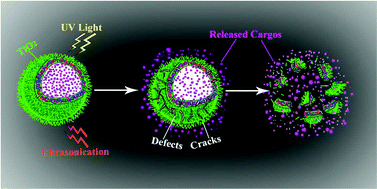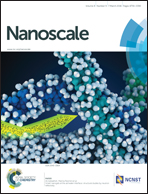Bifunctional ultraviolet/ultrasound responsive composite TiO2/polyelectrolyte microcapsules†
Abstract
Designing and fabricating multifunctional microcapsules are of considerable interest in both academic and industrial research aspects. This work reports an innovative approach to fabricate composite capsules with high UV and ultrasound responsive functionalities that can be used as external triggers for controlled release, yet with enhanced mechanical strength that can make them survive in a harsh environment. Needle-like TiO2 nanoparticles (NPs) were produced in situ into layer-by-layer (LbL) polyelectrolyte (PE) shells through the hydrolysis of titanium butoxide (TIBO). These rigid TiO2 NPs yielded the formed capsules with excellent mechanical strength, showing a free standing structure. A possible mechanism is proposed for the special morphology formation of the TiO2 NPs and their reinforcing effects. Synergistically, their response to UV and ultrasound was visualized via SEM, with the results showing an irreversible shell rapture upon exposure to either UV or ultrasound irradiation. As expected, the release studies revealed that the dextran release from the TiO2/PE capsules was both UV-dependent and ultrasound-dependent. Besides, the biocompatibility of the capsules with the incorporation of amorphous TiO2 NPs was confirmed by an MTT assay experiment. All these pieces of evidence suggested a considerable potential medicinal application of TiO2/PE capsules for controlled drug delivery.


 Please wait while we load your content...
Please wait while we load your content...